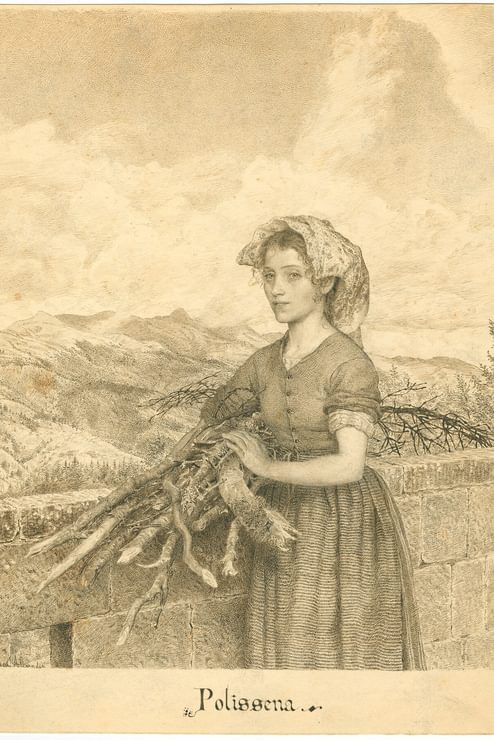Professor of Art Jacqueline Marie Musacchio ’89 talks about the artist Francesca Alexander and her circle as if they were her own friends. It is a familiarity born out of years of research, culminating with her book The Art and Life of Francesca Alexander 1837–1917, published in February by Lund Humphries.
Born in Boston, Alexander moved with her family to Italy when she was 16. Throughout her life in Florence, she translated Italian stories, songs, and poetry, honoring meter and rhyme in her English versions and scoring the songs. As a mostly self-taught artist, she drew the landscape and people around her with what Musacchio describes as almost dizzying precision. (It is unsurprising, Musacchio notes, that Alexander went blind later in life. “This kind of technique doesn’t do you any favors,” she says.) Alexander published three of her manuscripts with celebrated English writer and artist John Ruskin, including Roadside Songs of Tuscany, and another two on her own.
“Unlike most Anglo-Americans who went abroad, she didn’t ignore the Italians she encountered,” says Musacchio, who specializes in Italian Renaissance and Baroque art. “She spent time with them, hired them as models for her art, and provided them with charity; they considered her a friend.” Alexander used money from her family, and whatever she earned from her art and publications, to enable her charitable work.
“I think of her more as sort of a folklorist, rather than an artist,” says Musacchio. “For her, it was all about telling the story of people who lived these really hard lives in and around Florence and elsewhere in Italy, who had been pretty much downtrodden and abused by the government and other forces. She gave them a voice.”
Musacchio originally planned to include a chapter on Alexander in a book about Americans in Italy, but when the pandemic paused in-person research, she reevaluated that project. She realized that Alexander’s work—paintings, drawings, and publications, the background of which Musacchio has pieced together through Alexander’s correspondence with her friends and other sources—made for a separate book. It is the first scholarly monograph about the artist, and the project was possible, in no small part, because Musacchio had access to a trove of Alexander’s art held in Wellesley’s own Special Collections.
Looking through the materials with Musacchio, Ruth Rogers, Laura Daignault Gates ’72 Curator of Special Collections, says she was surprised that Alexander was still relatively unknown. From the historiated initials in a manuscript made for Bostonian Pauline Agassiz Shaw to her “very stylized, almost Gothic” calligraphy, the work is enchanting.
“It’s a really under-the-radar kind of collection that should be better known,” says Rogers. “And I think thanks to this new book, it’s going to be.”

Until now, insofar as there was a public narrative around Alexander, it emphasized her sheltered upbringing—Alexander’s mother allegedly did not let her look at paintings of nudes, for example—and Ruskin’s admiration of her.
“But in reality, she was a huge part of Anglo-American society in Florence in this period,” says Musacchio. “No one mentions that she knew all these important people. No one mentions that she integrated herself into Italian society in that way. They just talk about, ‘Oh, she’s so quiet and unassuming.’ And she was, but she also went out and did these things on her own, so she wasn’t isolated from society, and she made a huge impact on her community.”
Musacchio sometimes teaches a course on Americans in Italy, but she brings up Alexander’s work in her other courses, too. “It doesn’t quite fit with the syllabus, but I can’t resist it,” she says. “I think it’s great to be able to show the students the range of what we have here.” A collection like this, she says, is a tool for teaching, “but it also can allow you to do major scholarly work in your backyard.”
The Ruskin Connection
In 1920, Special Collections received its 866-volume Ruskin Collection from Boston bookseller Charles Eliot Goodspeed, whose daughters were alumnae. Goodspeed’s interest in Ruskin had extended to Alexander’s work, and he’d built an extensive collection of objects by both artists.
Alexander and Ruskin met only a few times, but they corresponded for years, as did Ruskin and Alexander’s mother. “Their relationship is this strange kind of combination of innocence and condescension,” says Musacchio, noting that Ruskin referred to Alexander as a girl, though she was 45 when they first met. When Alexander sold her Roadside Songs of Tuscany manuscript to Ruskin, it featured 122 drawings. He chose to include only 20 when he began publishing it in 1884, adding his own essays and other texts in place of the rest. (Alexander’s mother arranged the publication of a complete version of the manuscript, entitled Tuscan Songs, in 1897.)
“It’s often said that Ruskin discovered her. But I don’t think he had any influence on her art. He just made her more of a celebrity,” Musacchio says. “She was already a celebrity in the Boston area and among the Anglo-Americans in Florence, but Ruskin had a megaphone that she didn’t have, and he had the publisher, and once he came out and said, ‘I love the stuff,’ then other people did, too.”




Post a Comment
We ask that those who engage in Wellesley magazine's online community act with honesty, integrity, and respect. (Remember the honor code, alums?) We reserve the right to remove comments by impersonators or comments that are not civil and relevant to the subject at hand. By posting here, you are permitting Wellesley magazine to edit and republish your comment in all media. Please remember that all posts are public.